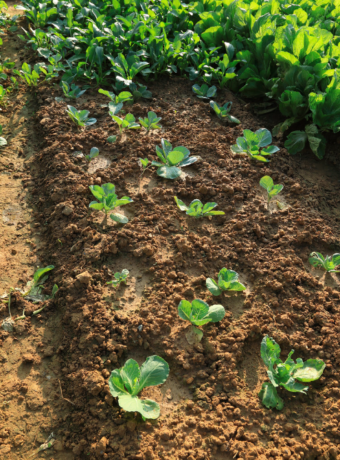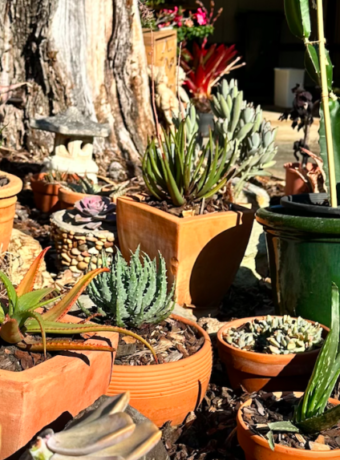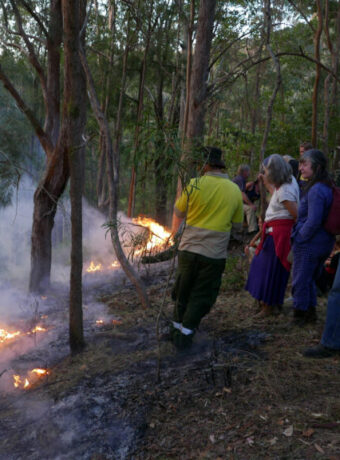My water garden is one of my favourite features of my little suburban permaculture garden. I took a neglected garden bed, and rather than just adding a pond, I tried replicating a natural wetland ecosystem with the appropriate types of plants surrounding the pond to maximise biodiversity and minimise the amount of effort I’d need to maintain it.
Wetland Ecosystems
A pond ecosystem is a small, enclosed body of freshwater, typically shallower than a lake. A wetland ecosystem is characterised by its water-saturated soil and support for diverse plant and animal species. It includes marshes, swamps, and bogs. While both have aquatic features, wetlands often have waterlogged soil and specific wetland plants, whereas ponds may not exhibit such extreme saturation.

Both wetland and pond ecosystems include the presence of water, support for aquatic life, and potential for biodiversity, and both ecosystems play important roles in water purification, habitat provision, and nutrient cycling.
In order to promote the most biodiversity, even in a small space, you should aim to include some elements of a wetland ecosystem around your pond or water garden. If I had a huge property or an existing dam, I’d try include upland, swamp, marsh, and aquatic zones, but for a small suburban space, a marsh and aquatic zone is relatively simple. This will also allow you to get a wide range of aquatic plants (indicated by the numbers 1 to 6 in the cross section diagram) as well as wetland plants, such as the meadow and emergent plants within the marsh zone:

Creating a Water Garden
I turned an old garden bed at the back of my yard that wasn’t really used for much else into a water garden. The location works well, the only challenge is that it is under a large leopard tree so sometimes there’s a lot of leaf litter that falls into the water. I don’t really mind though, this is a very low-maintenance garden for me, and I’m not too concerned with aesthetics, I prefer to let the system balance itself out. As long as my plants are growing healthy, I’m happy!
I was able to use things that were already in my garden, like plants, rocks, wood, bricks, and other bits and bobs, but I did have to spend some money. Creating the water garden cost a total of $425, spent over the course of a few months as I slowly built it in stages, and this includes everything I would need to maintain it for the coming years. The only additional expense might be some more plants!
The Pond
The central feature of a water garden is – you guessed it – water, and if we are aiming to replicate a wetland ecosystem this water would likely take the form of a pond. For the pond, you can use a pre-fabricated fibreglass pond liner, where you dig out a hole the same size then add the pond on top. These tend to be more expensive but they do look nice. If you’re on a bit of a budget like me, you could use a plastic tub or an old bathtub – just make sure to seal any holes.


For an even cheaper option, you can dig out the shape you want your pond to be and use a PVC pond liner to build your pond. If you are building a PVC pond, you may wish to add old carpet or something similar between the ground and the PVC to protect it from any sharp rocks or tree roots that might poke a hole through the liner.
If you want to ensure the pond stays clear, you can opt for a water pump or filter, or use chemicals, but these will not be suitable for many types of native fish or frogs. The best approach is to regularly observe your pond and see how it adapts to changes – chances are if you provide the right conditions initially, it will create its own balanced ecosystem after a while and you won’t need to interfere much.
Marsh / Boggy Zone
To create a marshy wetland you will need one or both of the following: a consistent source of water to keep things moist, and/or a way to retain moisture.
I used PVC pond liner to ensure some of the soil (for which I used coconut coir, which retains moisture naturally) surrounding the pond would remain moist. This is where I grow the water-herbs and plants like kangkong and water chestnuts that can grow directly in water or moist soils. This is great because it’s low-maintenance and I don’t need water the garden, so even if I go away for a while the bog will stay nice and moist. Due to the lack of nutrients in the coco coir, I add some water garden fertiliser to these plants ever 6 months.

The other option is to water the garden regularly. The other side of my water garden has regular garden soil that is free draining and won’t get boggy, but because there is a soaker hose that gets used almost daily, it stays wet most of the time. This is great for plants that aren’t necessarily water-plants and might be susceptible to root-rot, but that are thirsty drinkers, like celery, rocket (arugula) and taro. I don’t add any fertiliser to this part of the garden, only the occasional spray of seasol.
You will want to include a variety of plants – both aquatic plants, boggy/emergent plants, and those found in meadows. It’s important to also include grasses and sedges as well as any edible plants if you want to create habitat for insects and frogs.



